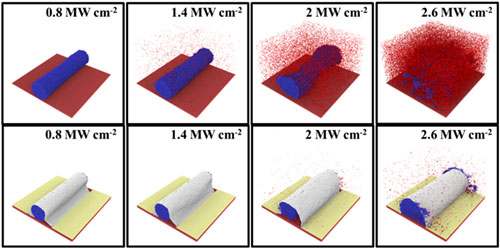| Posted: Nov 09, 2015 |
Advance could bring commercial applications for silver nanowires
(Nanowerk News) Silver nanowires hold promise for applications such as flexible displays and solar cells, but their susceptibility to damage from highly energetic UV radiation and harsh environmental conditions has limited their commercialization.
|
|
New research suggests wrapping the nanowires with an ultrathin layer of carbon called graphene protects the structures from damage and could represent a key to realizing their commercial potential.
|
 |
| New research shows wrapping silver nanowires, which are promising for applications such as flexible displays and solar cells, with graphene protects the structures from damage and could represent a key to realizing their commercial potential. The lower images depict how graphene sheathing protects the nanowires even while being subjected to 2.5 megawatts of energy intensity per square centimeter from a high-energy laser, an intensity that vaporizes the unwrapped wires. The upper images depict how the unwrapped wires are damaged with an energy intensity as little as .8 megawatts per square centimeter. (Purdue University photo) (click on image to enlarge)
|
|
"We show that even if you have only a one-atom-thickness material, it can protect from an enormous amount of UV radiation damage," said Gary Cheng, an associate professor of industrial engineering at Purdue University.
|
|
Devices made from silver nanowires and graphene could find uses in solar cells, flexible displays for computers and consumer electronics, and future "optoelectronic" circuits for sensors and information processing. The material is flexible and transparent, yet electrically conductive, and is a potential replacement for indium tin oxide, or ITO. Industry is seeking alternatives to ITO because of drawbacks: It is relatively expensive due to limited abundance of indium, and it is inflexible and degrades over time, becoming brittle and hindering performance, said Suprem Das, a former Purdue doctoral student and now a postdoctoral researcher at Iowa State University and The Ames Laboratory.
|
|
However, a major factor limiting commercial applications for silver nanowires is their susceptibility to harsh environments and electromagnetic waves.
|
|
"Radiation damage is widespread," said Das, who led the work with Purdue doctoral student Qiong Nian (pronounced Chung Nee-an). "The damage occurs in medical imaging, in space applications and just from long-term exposure to sunlight, but we are now seeing that if you wrap silver nanowires with graphene you can overcome this problem."
|
|
Findings appeared in October in the journal ACS Nano ("Single-Layer Graphene as a Barrier Layer for Intense UV Laser-Induced Damages for Silver Nanowire Network"). The paper was authored by Das; Nian; graduate students Mojib Saei, Shengyu Jin and Doosan Back; previous postdoctoral research associate Prashant Kumar; David B. Janes, a professor of electrical and computer engineering; Muhammad A. Alam, the Jai N. Gupta Professor of Electrical and Computer Engineering; and Cheng.
|
|
Raman spectroscopy was performed by the Purdue Department of Physics and Astronomy. Findings showed the graphene sheathing protected the nanowires even while being subjected to 2.5 megawatts of energy intensity per square centimeter from a high-energy laser, which vaporizes the unwrapped wires. The unwrapped wires were damaged with an energy intensity as little as .8 megawatts per square centimeter.
|
|
"It appears the graphene coating extracts and spreads thermal energy away from the nanowires," Das said. The graphene also helps to prevent moisture damage.
|
|
The research is a continuation of previous findings published in 2013 ("Co-Percolating Graphene-Wrapped Silver Nanowire Network for High Performance, Highly Stable, Transparent Conducting Electrodes").
|

